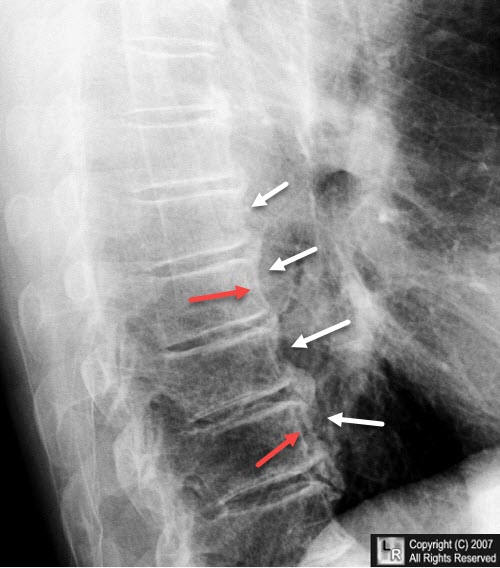|
|
Diffuse Idiopathic Skeletal Hyperostosis
DISH
General Considerations
- More common in Caucasian males aged 50-75 years
- Ossification of anterior longitudinal ligament with or without osteophytes is the primary pathology
- DISH is an enthesopathy – there is reaction at the sites of tendinous insertions (entheses)
- Laminated, flowing ossification
- Should involve four contiguous vertebral bodies
- Ossification is usually quite thick
- Disc height is maintained in affected area
- Does not have ankylosis of SI joints
- Involvement of SI joints excludes DISH
- Involves lower thoracic spine most often, but also cervical and lower lumbar spine most frequently
- Left side of spine in thoracic area tends to not have ossification because of pulsations of aorta
Clinical Findings
- Back stiffness or, less frequently, back pain
- Stiffness is worse in the morning
- Large osteophytes have also been reported to compress or obstruct a number of structures, including:
- Bronchus
- IVC
- Esophagus
- Increased incidence of calcification in surgical scars
- Associated with
- Hyperostosis frontalis interna
- Ossification of the posterior longitudinal ligament (OPLL)
- Ossification of the vertebral arch ligaments (OVAL)
Imaging Findings
- Conventional radiography is usually study of choice
- Flowing ossification along anterior aspect of vertebral bodies, but separated from them and the body
- Should involve 4 levels
- Ossification may thicken as disease becomes more chronic
- “Whiskering” at the sites of tendinous insertion (entheses)
- Pelvic involvement
- Iliac crests
- Ischial tuberosities
- Iliolumbar ligaments
- Lesser trochanter
- Deltoid tuberosities of humerus
- Olecranon spurs
- Also may have ossification of the
- Achilles tendon
- Plantar aponeurosis
- Triceps tendon
DDX:
- Ankylosing spondylitis
- Has involvement of SI joints
- Syndesmophytes are thinner
- Degenerative disc disease
- Osteophytes form only at corners of vertebral bodies
- Narrowing and desiccation of disc
- Acromegaly
- May produce osteophytes but they are not flowing
- Fluorosis may produce osteophytes, whiskering and ligamentous ossification
- But all bones are uniformly increased in density

Diffuse Idiopathic Skeletal Hyperostosis (DISH). There is flowing ossification
that spans more than four contiguous vertebral bodies while the disc height is maintained (white arrows).
For this same photo, click here

Diffuse Idiopathic Skeletal Hyperostosis (DISH). There is flowing ossification
that spans more than four contiguous vertebral bodies while the disc height is maintained (white arrows). There is also slight separation of the flowing osteophytes from the anterior aspect of the vertebral bodies (red arrows).
For more information, click on the link if you see this icon 
eMedicine: Diffuse Idiopathic Skeletal Hyperostosis, Khozaim Nakhoda, MD and Gary Greene, MD
|
|
|